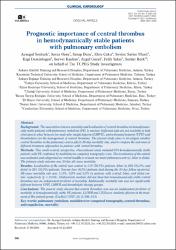Prognostic importance of central thrombus in hemodynamically stable patients with pulmonary embolism

Göster/
Erişim
info:eu-repo/semantics/openAccessTarih
2017Yazar
Şentürk, AyşegülÖzsu, Savaş
Duru, Serap
Çakır, Ebru
Ulaslı, Sevinç Sarınç
Demirdöğen, Ezgi
Kayhan, Servet
Güzel, Aygül
Yakar, Fatih
Berk, Serdar
Üst veri
Tüm öğe kaydını gösterKünye
Senturk, A., Ozsu, S., Duru, S., Cakır, E., Ulaslı, S. S., Demirdogen, E., Kayhan, S., Guzel, A., Yakar, F., & Berk, S. (2017). Prognostic importance of central thrombus in hemodynamically stable patients with pulmonary embolism. Cardiology journal, 24(5), 508–514. https://doi.org/10.5603/CJ.a2017.0021Özet
Background: the association between mortality and localization of central thrombus in hemodynamically stable patients with pulmonary embolism (PE) is unclear. Sufficient data are not available to help clinicians to select between low molecular weight heparin (LMWH), unfractionated heparin (UFH) and thrombolytics for the management of central thrombus. the present study aims to investigate whether central thrombus in the pulmonary artery affects 30-day mortality rate, and to compare the outcomes of different treatment approaches in patients with central thrombus. Methods: This multi-central, prospective, observational study included 874 hemodynamically stable patients with PE confirmed by multidetector computed tomography scan. the localization of the emboli was evaluated and categorized as central (saddle or at least one main pulmonary artery), lobar or distal. the primary study outcome was 30-day all-cause mortality. Results: Localization of the emboli was central in 319 (36.5%) patients, lobar in 264 (30.2%) and distal in 291 (33.2%) patients. Seventy-four (8.5%) patients died during the 30-day follow-up period. All-cause mortality rate was 11.9%, 6.8% and 6.2% in patients with central, lobar, and distal emboli, respectively (p < 0.001). Multivariate analysis did not show that hemodynamically stable central thrombus was an independent predictor of mortality. Additionally, mortality rate was not significantly different between UFH, LMWH and thrombolytic therapy groups. Conclusions: the present study showed that central thrombus was not an independent predictor of mortality in hemodynamically stable PE patients. LMWH and UFH were similarly effective in the treatment of this patient group.

















